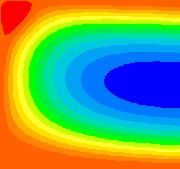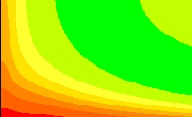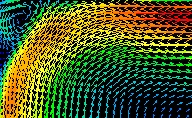
Turbulent Flow: Ra = 3.38E+06
Introduction
This case is given the same dimensions as case2 (.15m high and .31m wide) but the temperature difference between the top and the bottom wall is increased --thus increasing the Rayleigh number. The bottom wall is now 305K and the top wall is 295K. The same 40x80 mesh is used with a stretching factor of 1.5 in the x-direction.
Convergence:
HEAT FLUX: Expected vs. Actual-Expected heat flux: q = 14.27W/m^2 (According to the Nusselt number equation derived from experiments done by O'Toole and Silveston(1961)). Actual heat flux: q=13.55W/m^2
Graphical Representations of Selected Results
-
 Temperature Field (K)
Temperature Field (K)
-
 Velocity Profile (m/sec)
Velocity Profile (m/sec)
-
 Velocity Field (m/sec)
Velocity Field (m/sec)
-
 Streamline Contour (m^2/sec)
Streamline Contour (m^2/sec)
Analysis:
The most noted feature of this case is the formation of a single vortex of air flow within its domain. In the beginning of the run, two cells emerge and dominate the region, resembling the behavior of air flow in case1. However, small eddies soon appear in the lower corners similar those of case2. There after, these eddies grow and force the original two cells to decrease in size and in velocity so that the domain appears to be occupied by four vortices. The four vortices then break down to form one cell of air flow with a maximum velocity of 10cm/sec. As a result, all residual values fall as the solution converges quite nicely.